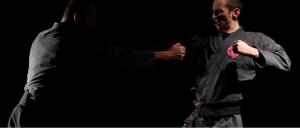The 改善 Kaizen of Charlie Chaplin
From Bujinkan Santa Monica by Michael
| Michael Glenn Holds Hatsumi Sensei's Chaplin Caricature. photo by Lisa Peters |
This drawing that Sensei made looks cartoonish. But it contains a very deep insight for our Bujinkan training. This comes from a Chaplin quote that Soke is fond of. The quote that Hatsumi Sensei frequently refers to goes like this,
そんなチャップリンに新聞記者が質問をします。「あなたの最高傑作の作品は何か?」と。そのとき彼はこう答えます。すなわち、「次の作品だ」と言ったのです。To paraphrase, a reporter asked Chaplin, which of your films do you consider the best? Chaplin replied, "the next one." This means the one that hasn't been created yet. Or as Sensei implies, the henka that hasn't happened yet.
This concept in Japan is tied in with the idea of 改善 kaizen. or continuous improvement. You continually work, evolve, and change. Never stopping because the next one will always be better.
Hatsumi Sensei told us that this next one is the one you cannot see. It is shrouded like 幽玄 Yugen. Floating in a world of potential. Thus, it cannot be countered.
Soke described it further,
"It's almost like a ghost or a ghoul. If you look at the classic films of Chaplin and the other mime actors, they're creating that space. If you understand this, this will take you in a very different path in your long progression."He wants us to have that space in our movement. To be comfortable in not deciding anything. No technique. Just floating in that kyojitsu space that you create. This is a safe space for you, but deadly for your opponent.
Below the drawing of Chaplin that Sensei made for me, he wrote:
次 次 次 tsugi tsugi tsugi
Next next next...
Keiko#22 TOGAKURE-RYU NINPO-TAIJUTSU with LUBOS POKORNY
From Budoshop by BUDOSHOP.SE
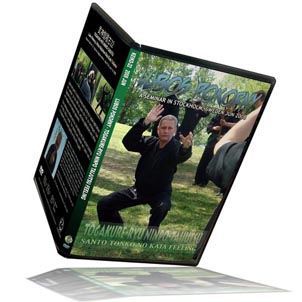

- 125 minutes, 1.26 Gb for $19.99
(h.264 M4V/MP4 400p format)
Available as download or full DVD!
Lubos had spent 3 months training and teaching in Japan right before he came for this seminar. On this video he covers the first six techniques from Togakure-ryu Santo Tonko no Kata, and many different applications with different weapons and multiple opponents.
The training was relaxed and fun, the feeling was just as the trainings in Honbu dojo in Japan. It was a beautiful weekend and the training was outside. Lubos had a microphone on so you can hear him very good..
Recorded in Stockholm May 2008
The instructions is in English.

About the instructor
Lubos Pokorny (Shihan 15th Dan Happo Biken) is a student of Dr. Masaaki Hatsumi, the 34th Grandmaster of Togakure Ryu Ninjutsu. As such, he has traveled around the world to take part in Hatsumi Sensei’s training events. During these travels Lubos represents the Czech Republic, beginning his training in 1991, he is the first Czech student of the Bujinkan as well as the founder of the Bujinkan Czech Dojo.
During his stays in Japan, usually 4-5 months per year he also teaches at the Hombu Dojo.
See his web site… bujinkandojo.eu/lubos.php
About the download
Click here for more information about our download files and how it works!…
Keiko#23 BIKENJUTSU with MATS HJELM
From Budoshop by BUDOSHOP.SE
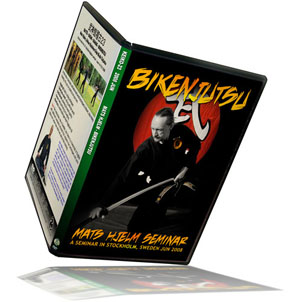

- 90 minutes, 883 Mb for $19.99
(h.264 M4V/MP4 400p format)
And 4 page transcript (in English)
Available as download or full DVD!
This movie deals with Batto (quick drawing the sword), Ukemi (breakfalling with a sword), Sword Kamae, and Sword techniques. There is many basics and more advanced techniques, training drills and more.
- Happo-giri, basic cutting techniques
- Taihenjutsu ukemi, rolling with the sword
- Batto/Iainuki, drawing the sword quickly
- Kamae, body positioning and angling
- Bikenjutsu, sword techniques from Togakure-ryu
Recorded in Stockholm June 2008
The instructions is in Swedish, but the instructions is very visible and clear. But we included a 4 page transcript, comments and descriptions in English.
About the instructor
Mats Hjelm started training in Bujinkan for the first time around 1983, but it wasn’t until 1986 he had the opportunity to start training more seriously under a Shidôshi. He attends around 20 seminars, go to Japan 2-3 times every year. Since he started training he never had a training break. He takes his budo training very seriously! If you want to sponsor a seminar or course, please don’t hesitate to contact him. For more information see his web site www.kesshi.com Note!
About the download
Click here for more information about our download files and how it works!…
Keiko#21 TOGAKURE-RYU SANTO TONKO NO KATA with MATS HJELM
From Budoshop by BUDOSHOP.SE
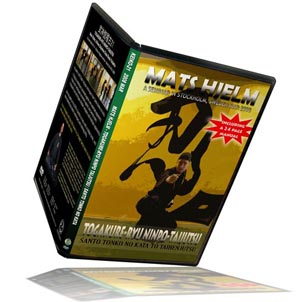

- 115 minutes, 1.2 Gb for $19.99
(h.264 M4V/MP4 400p format)
And 24 page pdf booklet
Available as download or full DVD!
This movie contains all 9 techniques from the Togakure-ryû Santo Tonko no Kata. The strategy of the fleeing rat is a collection of 3×3 techniques for quick self defense and then flee away safely.
- 3 Taijutsu techniques (unarmed against one unarmed opponent)
- 3 Muto-dori techniques (unarmed against one swords man)
- 3 Kakushi-buki techniques (hidden weapons against multiple opponents)
Also included on this movie is Sanshin no kata using a hidden knife, plus many taihenjutsu (breakfalling) techniques and training drills.
Included is also a 24 page pdf booklet with the Santo Tonko techniques.
Recorded in Stockholm May 2008
The instructions is in English and there is some subtitles explaining things which is not obvious.
About the instructor
Mats Hjelm started training in Bujinkan for the first time around 1983, but it wasn’t until 1986 he had the opportunity to start training more seriously under a Shidôshi. He attends around 20 seminars, go to Japan 2-3 times every year. Since he started training he never had a training break. He takes his budo training very seriously! If you want to sponsor a seminar or course, please don’t hesitate to contact him. For more information see his web site www.kesshi.com Note!
About the download
Click here for more information about our download files and how it works!…
the store crashed!
From Budoshop by BUDOSHOP.SE
Few people are interested in DVD’s these days, we got maybe 1-2 orders a month the last year. We had an SSL / https certificate that just expired, and with that the store crashed. It is not really that important to have https on the store until you check out, so we decided to not extend the SSL certificate. Right now I’m trying to fix the errors so that it will work with just http (unencrypted).
Note, it is not really anymore unsafe if we switch of https on our site because your payments are all handled on PayPal which always is https/SSL encrypted. When the payment is done you get redirected back to our server. We never see your payment details, PayPal tells us if the transaction was done or not, that is all the information we get.
Mean while we will try to speed up and make all our DVD’s available for download except a few, those that is not our productions almost all the Ed Martin DVD’s and half of the Dean Rostohar DVD’s. Almost all the others is our productions and will be available as soon as possible.
I have a feeling that it will be too difficult to fix the store, so you can email us if there is a particular DVD you want to buy. We can make the order manually through PayPal.
The Downloads store was not affected by this.
Look at this page where you can see all our products (I’m updating it now!)…
Hidden Door of 三身 Sanshin
From Bujinkan Santa Monica by Michael
| Asura in Kōfuku-ji, Nara. photo by 小川晴暘 |
Ask your teacher what it is. Many will give you their pat, standard answer given to all beginners. Others will wander off in a glassy-eyed, meandering philosophical and esoteric treatise. And there are even some who will try to tell you how to stand or step while delivering a punch.
They may not be wrong. But they probably will be missing key ideas. I will not try to correct anyone except to say, please discard what you think you know.
Hatsumi Sensei recently gave us a clue to the secrets of sanshin when he was teaching us about kaname:
全体を捕るということは、要をとる。三身一如のことは言う。Soke suggests here that you take everything together by only taking what is essential in the moment (kaname). This is sanshin unified as one reality. Three as one.
To me this is like the hidden door of Togakure, an opening to understanding sanshin. When you open this door you find your reflection in a mirror. The secret is polishing the mirror (and your heart) with training so that reflection is pure like the clear water of 平常心 Heijōshin.
You may have heard about 三心 sanshin. And that is good. In Budo this is 心技体 shingitai: mind/spirit/heart; technique; body. Or if you want to be more philosophical: 身心識 body; heart; consciousness.
These are important ideas. But Soke used the kanji 三身一如 for sanshin ichinyo. This implies more of a Buddhist cosmology. 三身 is the trikāya or threefold body of the Buddha. This symbolism is complex but I will polish the mirror a bit.
The first is the Dharmakāya, truth body. This reflects your essential nature and character. This begins with a new student who studies hard, rarely missing a class. Staying true to the kihon and forms until a breakthrough of understanding occurs (for some students, around Godan level). Looking for the limits of your nature, you discover your truth to be limitless.
The second is the Sambhogakāya, or reward/retribution body. If you trained well, you may reap the reward of joy in life and training, or blissfully enduring battle. Your reflection will be pure in the mirror. If you did not train well, your frustrations in life, the dojo, or losing and being injured in battle, will surely shatter the reflection.
Third is the Nirmāṇakāya, the manifested body or actual physical form. This transformational form also embodies henka. Take your clothes off to see this one in the mirror. Maybe you don't want this reflection to be too clear!
So how do we use this in class or combat? Soke says 三身一如. Bringing the three together as one at the essential moment (kaname). If you have not been polishing well, this will be impossible.
Another three faced symbol shows us what NOT to do: the 阿修羅 ashura or fighting demon. These are the reflections of students who are obsessed with ego, force and violence. They may be quick to anger, full of pride, envious of others, insincere with their motives, false or fake in their persona, boast full, lazy or worse... bellicose.
The mirror of the heart dims. What this means is that they are unable or unwilling to learn or train Bujinkan as it is taught. If they are teachers, they often trap themselves along with their students.
But if you unify 三身 sanshin in combat, the results are really miraculous. I've witnessed it. I've experienced it myself. Trust me, you want this. Are you ready to study Sanshin?
Secrets of 三つ鱗 Mitsu Uroko
From Bujinkan Santa Monica by Michael
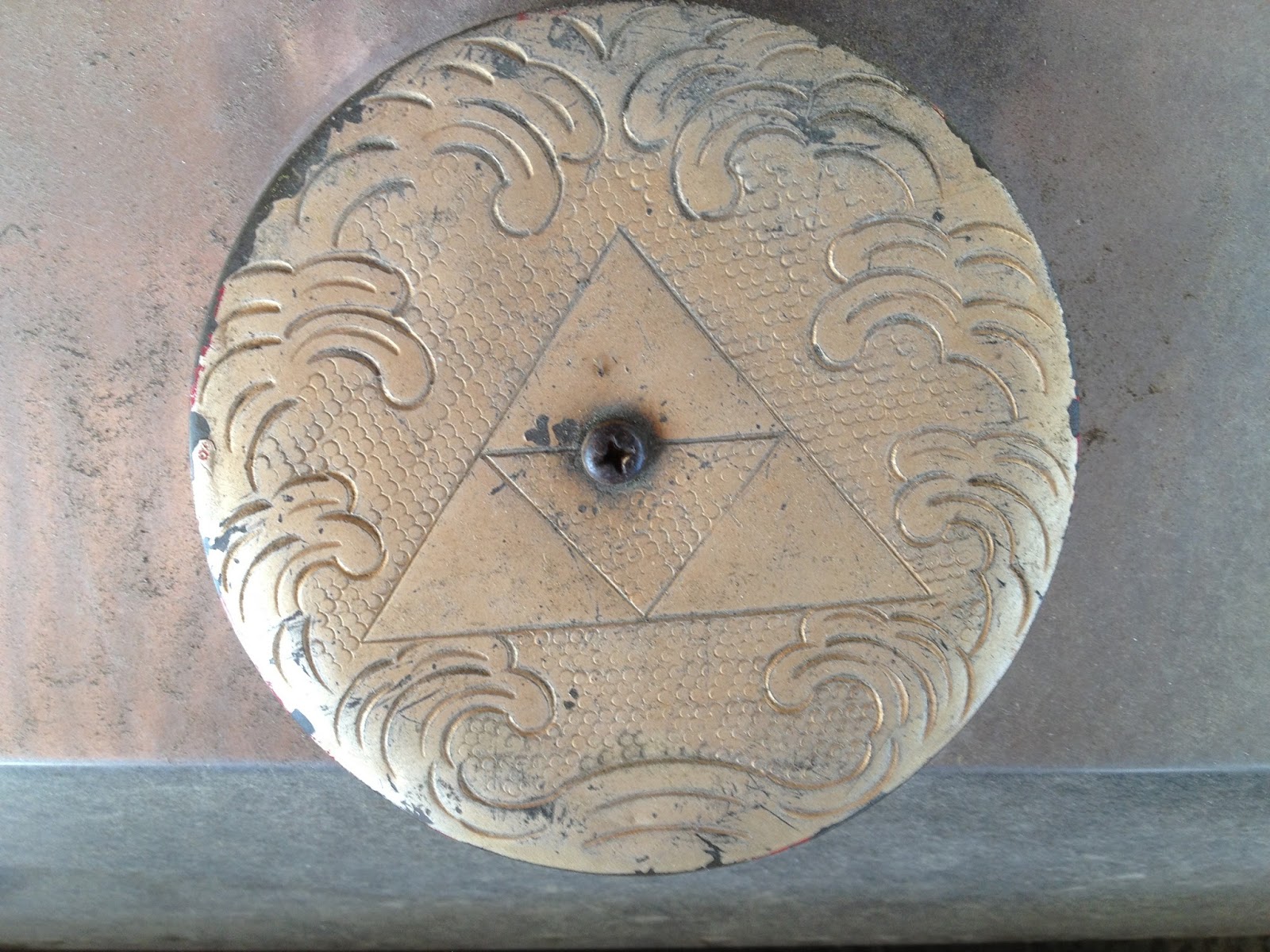 |
| 三つ鱗 Mitsu Uroko photo by Michael Glenn |
You have probably seen this symbol. For Legend of Zelda fans it is known as the Triforce. But you may not know that the creator of this game, Miyamoto Shigeru, took much of his inspiration from the mountains and temples of Kyoto. And if you travel around Japan, you will encounter this symbol yourself.
What does it mean? And why should anyone in the Bujinkan care? Let me explain.
The origin story of this symbol is tied with one of the most powerful Shogun and clans in Japanese history.
As told in the Taiheiki 太平記, Hojo Tokimasa went on a pilgrimage of fasting and prayer to the island of Enoshima. While he was in one of the Iwaya Caves, the Goddess Benzaiten appeared to him. She said that since he had been a priest in a previous life, he and his family would prosper and rule over Japan.
After her blessing, Benzaiten returned to the sea. As she slipped beneath the waves, Tokimasa caught a glimpse of a dragon's tail sliding across the sand from beneath her robes. This vision caused him to investigate her tracks in the sand and he found three dragon scales that had flaked off.
 |
| Benzaiten Appears to Hôjô Tokimasa (notice she holds 3 scales) |
These three dragon scales became their 紋 mon (family crest) as the Hōjō clan rose to prominence during the Kamakura period in Japanese history. They changed history by facing off with invading Mongols, spreading Zen Buddhism, and the foundation of Bushido. But they also had secret police and had very secretive meetings at private locations to control Japanese society.
Sometimes when you find this symbol in Japan it is part of an antique shrine. But sometimes it is in places that could represent a secret meeting spot. Does the secret cult of Uga-jin 宇賀神 still have power?
Could there be secret meetings still happening to this day? Nahhh…
Remember These 3 Steps Next Time You Get Confused In Your Bujinkan Class
From Bujinkan Santa Monica by Michael
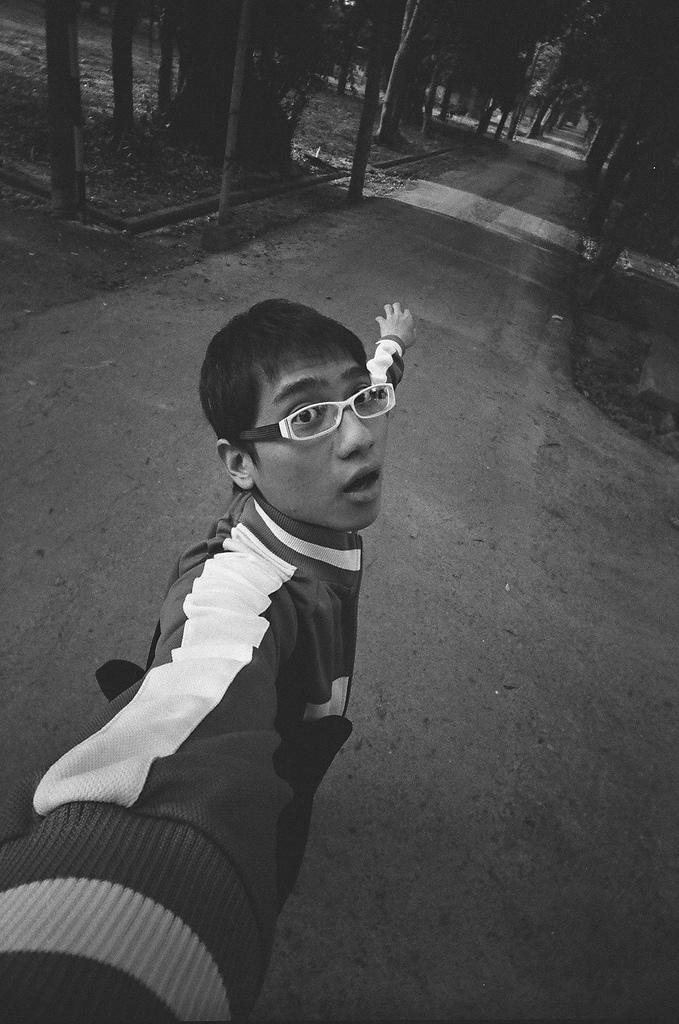 |
| 自拍的藝術 photo by 【J】 |
If you study with me, I add a secret teaching technique that I will call "Michael Glenn's Patented 秘密 Himitsu Bujinkan Strategy™." I use this silly name because I want you to try to figure out what it is. If you can guess it, I will send you a free DVD.
So if you want to be successful in your Bujinkan class, there are 3 simple steps:
(add Michael Glenn's 秘密 Himitsu Bujinkan Strategy™ first) then,
- Attempt
- Observe
- Repeat
Attempt. It is better to start by trying. Until you try, you don't even know if you can do it. Until you try, you don't know where your mistakes will be. This is the only way to know what to look for in the next step.
Next, Observe someone who is successful. In your Bujinkan class, this can be your teacher, the senior students, or even your training partner.
(This is another great spot for more of Michael Glenn's 秘密 Himitsu Bujinkan Strategy™.)
When you repeat, you will make your next attempt more knowledgeable based on your observations. Your next try will be more refined, with less mistakes. Soon you will be the example that other Bujinkan students want to observe.
If you are a teacher, set up your Bujinkan class with these steps for success. Too many teachers teach for the wrong reasons. Know your purpose as a teacher: The focus is not to teach, or to test. A teacher’s job is to facilitate learning.
The funny thing is, everyone reading this article is a Sensei. I firmly believe that our whole lives we are our own greatest teachers. But you are at the same time your own best and worst student.
Who demands smart training? Who will do this with intention? I have no doubt that my students will succeed.
The question is, are you going to be your own best teacher? Will you keep going? Will you be the example?
PS. send me an email with your answer to What is Michael Glenn's 秘密 Himitsu Bujinkan Strategy™? get a free DVD if you guess my secret teaching technique.
